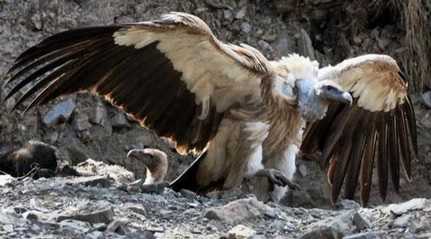
Agartala, Feb 6 (PTI) Tripura's forestry department is embarking on a project to breed the endangered vulture specie in Khowai district through program for vulture conservation and artificial breeding'.
The decision was taken after it was noticed that Khowai had higher concentration of vulture population, said officials who added that vultures would be brought in from other states to help in the artificial breeding.
The project would soon be set up at Padmabil area in Khowai district with money sanctioned by the central government. There would be artificial breeding by bringing vultures from Haryana and then the offspring would be released in wild , Divisional Forest Officer (DFO) of Khowai, Niraj K Chanchal said.
Recently around 30-40 vultures were sighted in the district. About a decade back the scavenger bird was almost extinct in the state, but the population is on the rise now due to improvement of their habitat by the forest department , he said.
The Conservation Breeding Program appears to be the only action, which could save the vultures from extinction, Principal Chief Conservator of Forest (PCCF), D K Sharma said.
If 150 pairs of each of the three species could be held and bred in captivity, it would be possible to get a derived population of 600 pairs of each of the three species, within ten years of the beginning of release programme. This will form a genetically diverse and self-propagating population , he reasoned.
So far only three centers have been set up by state governments and Bombay Natural History Society.
Explaining the reasons behind the increase in numbers of vultures, Chanchal said, it was observed that plantation of leafy Shimul trees on the river bank helped improving the habitat, which had been depleted earlier by de-forestation. Vultures have also learnt to adapt to the scarcity of food to some extent by consuming carcasses of animals floating on the river.
We also launched an awareness campaign among the locals for planting more Shimul trees, because the vultures roost in such leafy trees and not to give diclofenac (an anti-inflammatory drug) to their livestock (as this enters the food chain and causes renal failure in vultures) . People have responded well to our requests , he said.
Even after taking the measures, the scavenger bird still faces a food crisis and to meet it, the forest department plans to set up a vulture colony, with abundant food options and a suitable ecosystem.
Among the nine species of the birds sighted in the country, white-rump-ed vulture found in Tripura has been identified as critically endangered by IUCN.
Although India has banned manufacture of diclofenac tablets for animals, the pills are being manufactured for human use. Farmers often illegally use these tables to treat cattle.
Prasenjit Biswas, an ornithologist who authored The Last Flight of the Vulture, said human incursion and unavailability of food were the major reasons behind the decline in the big bird's population.
The Rudra Sagar Lake, its surroundings and the Sipahijala sanctuary, with its large lakes and forests, used to be a favourite haunt of white-rumped vultures till the late 1980s, he said.
Human corpses are rarely dumped in the open, while animal carcasses are also now safely disposed off. This has deprived the vultures of their food source," Biswas, who has been studying the movements and traits of vultures for over a decade, added.
There were only 55 vultures sighted in the State in 2013 according to a survey by the department.
However, no survey of vultures has been carried out since then.
The population of vultures in the Indian subcontinent crashed during the 1990s. This was first reported and documented in 1996-97 by the Bombay Natural History Society (BNHS), while monitoring raptors numbers in Keoladeo National Park, at Bharatpur in Rajasthan. The BNHS conducted nationwide raptor surveys in many parts of India between 1991 and 1993 and the survey was repeated in 2000 and the results were dramatic.
The populations of Oriental White-backed Vulture and Long-billed Vulture had declined by more than 92% between 1991-93 and 2000. By the year 2007, the population had declined by an astonishing 99.9 % for Oriental White-backed Vultures and by 97% for long billed and slender billed vultures. All three vulture species were listed by IUCN, the World Conservation Union, in 2000 as Critically Endangered,' which is the highest category of endangerment , Sharma told PTI.
This assessment indicated a high risk of global extinction in the wild in the near future. The vultures are also listed in the Schedule-I of the Indian Wildlife Protection Act (1972) which is the highest category of protection for Wildlife in the country.




